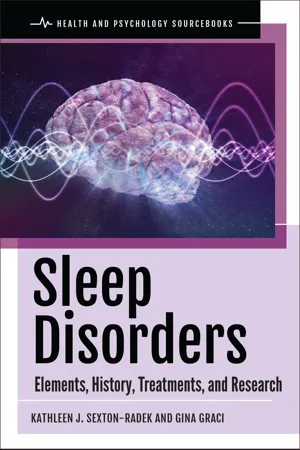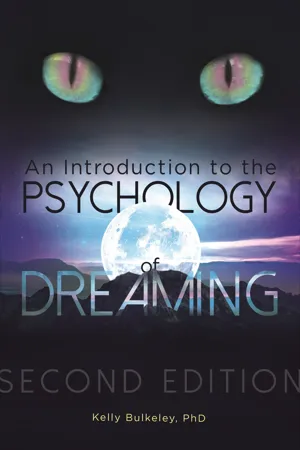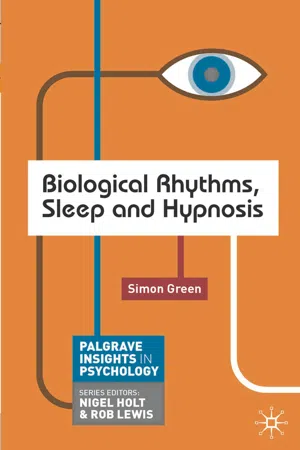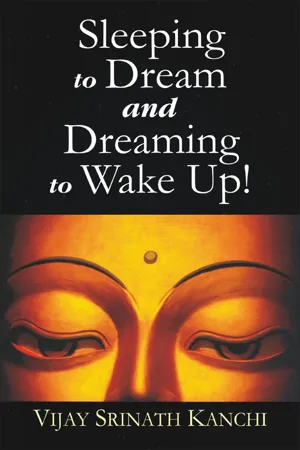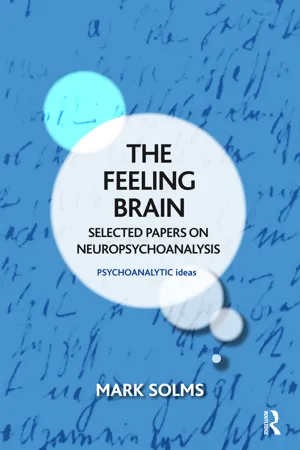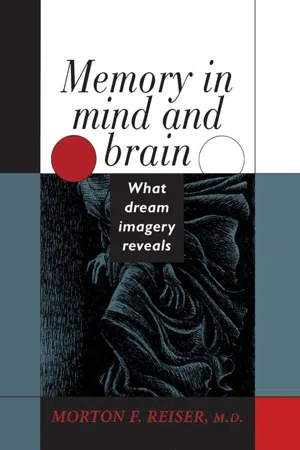Psychology
Dreaming
Dreaming is a complex mental process that occurs during sleep, involving vivid sensory experiences, emotions, and thoughts. It is characterized by the presence of vivid, immersive imagery and a suspension of critical thinking. Dreaming is believed to serve various psychological functions, such as processing emotions, consolidating memories, and problem-solving.
Written by Perlego with AI-assistance
Related key terms
1 of 5
9 Key excerpts on "Dreaming"
- eBook - ePub
Sleep Disorders
Elements, History, Treatments, and Research
- Kathleen J. Sexton-Radek Ph.D., Gina Graci(Authors)
- 2021(Publication Date)
- Praeger(Publisher)
CHAPTER 10 Dreaming as a Psychological ProcessW hy do we dream, why are some dreams frightening, and why do we only remember some of our dreams? Hypotheses have abounded for years regarding the meaning and biological or neurological pathway of dreams. Some people earn a living by analyzing dreams, but what do dreams really mean, and what is the current dream landscape? The symbolic meaning of dreams is called the latent content of dreams, and many people believe there are hidden messages in dreams. Some scientists believe that Dreaming is related to depression, and some therapists postulate that if the unconscious meaning of dreams can be interpreted, then psychological distress could be relieved (Cherry, 2020). This chapter will explore Dreaming as a psychological process.A dream is defined as a physiologically and psychologically conscious state that occurs during sleep. It is often characterized by a rich array of endogenous sensory, motor, emotional, and other experiences (American Psychological Association [APA], 2020). Dreams mainly occur in rapid eye movement (REM) sleep and may be logical or illogical. Dream interpretation is the attempt at finding meaning from dreams as it applies to an individual’s life.Sigmund Freud believed that the meaning and content of dreams were heavily encrypted and hard to translate (Lyon, 1990). The hidden meaning of dreams played an important role in Freud’s psychoanalytic theory, and he believed that bringing the hidden meaning of a dream into conscious awareness could relieve psychological distress (Freud, 1913). For instance, Freud believed that the latent content of a dream was not only suppressed but hidden by the subconscious mind to protect the person from thoughts and feelings that were hard to cope with (Cherry, 2020).While the function of sleep is hypothezied to be based on restorative properties, there is no concluding evidence that this is true. The early work of Dr. Rosalind Cartwright (the Grandmother of Sleep) showed the scientific measurement of sleep and Dreaming, primarily dreams and the process of Dreaming. “Dreams,” wrote Cartwright, “are our private perceptions which cannot be validated or shared by others” (Cartwright, 1977). She also postulated that dreams may “provide us with a direct cure for certain mental problems long before anyone determines exactly what sleep and Dreaming are for” (Lyon, 1990). - Kelly Bulkeley Ph.D.(Author)
- 2017(Publication Date)
- Praeger(Publisher)
Dream reports gathered from people sleeping in the laboratory indicate that the vast majority of dreams obey the same basic rules of logical association that govern our waking thought and language. While Foulkes grants that dreams do Cognitive Psychology and Dreaming 89 emerge out of personally relevant thoughts and emotions, he sees no proof that dreams are saying anything in particular. Unlike waking speech, dreams are not intended to communicate a specific message: “I conclude that we have no sense of intention during Dreaming and we are unable, asleep or awake, to reconstruct plausibly why we dreamed a par- ticular dream because there was no intention in the formation of any particular dream image” (Foulkes 1982b, 176–177). For Foulkes, as for Freud, the essence of Dreaming is a set of cognitive mechanisms by which thought and language are structured: “That is, mechanisms whose investment is not so much in saying any particular thing as in insuring that whatever is said is literally and thematically comprehensible” (1982b, 186). Foulkes’s key argument is that the sleeping mind is not functionally distinct from the waking mind. The human mind is always operating as an information-processing system, whether it is producing waking thoughts during the day or dreams during the night. Although he is skeptical about any effort to interpret special meanings hidden in dream contents, Foulkes affirms that Dreaming probably does serve a number of valuable psychological functions: • The complex stories and plots found in dreams suggest that Dreaming allows people to exercise their powers of narrative integration, making symbolic knowledge more easily accessible to waking consciousness: “Becoming human is, from this perspective, learning to understand and to be able to tell ‘stories.’ Dreaming surely might play some role in this pro- cess” (1985, 202).- eBook - PDF
- Antti Revonsuo(Author)
- 2017(Publication Date)
- Routledge(Publisher)
The cognitive approach criticized the Activation–Synthesis view of Dreaming as being based more on stereotypical anecdotes and biased memories of dreams, not on proper representative samples of dreams collected for research purposes. Thus, in the 1980s and with the rise of the cognitive approach in particular, Dreaming was again taken seriously as a form of consciousness or subjective mental experience in 110 Dreaming psychology. Dream experience was again studied systematically by looking at detailed introspective dream reports. Dreaming was to be explained by either the underlying cognitive or neural mechanisms, or both in combination. With the advent of cognitive neuroscience and consciousness studies in the 1990s, scientific dream research became a natural part of these fields. Also, philosophers became newly interested in the relationships between Dreaming, consciousness, and the brain (Revonsuo, 2006; Windt, 2015). This development is fortunate for modern consciousness research because ASCs related to sleep and Dreaming are the most commonly occurring altered states in normal adults, and hence a most valuable source of data and evidence about consciousness. We sleep about eight hours per day or one third of our lives. It is sometimes mistakenly stated that when we are asleep we are not conscious at all, but most of the time that we spend sleeping we are in fact in some kind of altered state of consciousness rather than totally unconscious. Next we will take a look at the rich variety of ASCs that occur during sleep. Hypnagogic and hypnopompic hallucinations “Hypnagogia” is the brief transitional state from wakefulness to sleep (literally, “leading to sleep”). The internally generated images in this state are called hypnagogic hallucinations . By contrast, hypnopompic hallucinations (meaning literally, “leading out of sleep”) occur in the transitional state from sleep back to wakefulness. The contents of the hallucinations are quite similar in both stages. - eBook - PDF
- Simon Green(Author)
- 2017(Publication Date)
- Red Globe Press(Publisher)
108 Chapter X Dreams Chapter 5 Introduction We are such stuff as dreams are made on, rounded with a little sleep! (Shakespeare, The Tempest , Act 4, scene 1) The phenomenon of dreams has fascinated people since the earliest times, with frequent references from the earliest recorded writings. For instance, in the Bible, Joseph’s ability to interpret the dreams of the pharaoh leads ultimately to the liberation of the people of Israel. Dreams are clearly a special state of awareness. Although we cannot recall all our dreams in the morning, we know that, in the dreams we do remember, we are ‘conscious’, responding to people and situations in much the same way we do when awake. This means that dreams represent at least primary consciousness, the basic awareness and reactivity that we see in animals (this was discussed in Chapter 1). However, in the dream we are not aware that we are Dreaming, that is, we do not have ‘self-awareness’, the higher order consciousness that characterizes our waking behaviour. Dreams are undoubtedly a fascinating phenomenon, but they have proved remarkably difficult to study from a scientific perspective. There is one simple reason for this; dreams are part of our individual, subjec-tive experience. No one else has access to the content of our dreams, and they only know we have had them because we tell them. The methods of science rely on objective measurement or assessment, and have few tech-niques for dealing with subjective experience. Another problem with research into dreams is that the earliest system-atic theories were based in the psychodynamic approach of psychologists such as Freud and Jung, as discussed in Chapter 1 in relation to conscious-ness. For most of the twentieth century, psychodynamic psychology and 109 Dreams scientific experimental psychology were mutually incompatible. Freud, for example, was seen as non-scientific, in that his ideas were not easily testable using scientific techniques. - eBook - ePub
- Vijay Srinath Kanchi(Author)
- 2022(Publication Date)
- D.K. Printworld(Publisher)
. The idea that Dreaming is some form of madness is an age-old concept. In the Preface to his book Dreaming as Delirium , Allan Hobson (1999) thinksDreaming is more similar to delirium than to any other kind of psychosis. He contends that every time as we sleep some organic changes occur in our brain which upset the physiological balance of the brain resulting in thedelirium syndrome. He says that the Dreaming mind has four characteristics that are equally applicable to delirium: visual hallucinations, disorientation, recent memory loss and confabulation.The state of deep and dreamless N3 sleep is highly regarded by Vajrayāna Buddhism and Advaita Vedānta as the state in which we establish contact with our innermost consciousness. This region is the creative source of all our mental and sensory experiences and the experience of subject–object duality. However, this contact with our core self is made without our awareness and conscious control. Meditative practices are meant to bring this aspect of our being into our awareness and even under conscious control.It seems upon sensory deprivation and deep absorption into the mental phenomenon that is characteristic of deep meditation, visualization and Dreaming, our minds activate the cholinergic system and in the absence of stronger and distracting sensory stimuli, the mental imagery takes a concrete form.In all these different thought forms, one thing is common: that they are all our experiences and we experience them with involvement and seriousness and hence they are real for us as long as they last.StephenLaBerge (2014) provides different scenarios that make our consciousness change its state. When we are awake and actively engaged in some task such as talking to someone or walking on a street, our brain attentively processes the sensory stimuli coming from the external world and taking aid of the memory,constructs a model of the world. As the stimuli coming from the senses become routine and unimportant, we unknowingly drift into - David Foulkes, David FOULKES(Authors)
- 2009(Publication Date)
- Harvard University Press(Publisher)
In this regard, they provide the first really new insight into Dreaming since the discovery in the 1950 s of REM sleep, and the demonstration of its relation to particularly memo-rable Dreaming. We now see that Dreaming is a very high-level cognitive process that has skill prerequisites lacking in infancy and which unfold slowly in the preschool and early primary-school years. We now know that Dreaming is not an elementary and automatically engaged adjunct of waking perceptual processes, and that it cannot, therefore, be imagined to be present in every creature whose waking behavior is visually (or otherwise sensorially) guided. To dream, it isn’t enough to be able to see. You have to be able to think in a certain way. Specifically, you have to be able, in your mind’s eye, to simulate, at first momen-tarily and later in more extended episodes, a conscious reality that is not supported by current sense data and that you’ve never even experienced before. Now, the question might be raised whether this notion of Dreaming, the imaginal simulation of a novel “reality” in the absence of supporting sense data (which certainly embraces our adult notion of what a dream is), exhausts the possible forms of sleep mentation that could occur in very young chil-dren or other animals. Maybe, for instance, infants and ani-mals have nonreflective forms of sensation during sleep not at all like our Dreaming, but still “occurring involuntarily in the Dreaming 117 mind during . . . sleep” (see the dictionary definition cited earlier). I have taken “in the mind” to mean consciously experi-enced, and in that sense I don’t think these hypothetical non-reflective sensations in sleep could qualify as Dreaming in any manner that would be at all faithful either to everyday linguis-tic usage or to the pursuit of scientific psychological inquiry.- eBook - PDF
Mapping the Mind
The Intersection of Psychoanalysis and Neuroscience
- Fred M. Levin(Author)
- 2018(Publication Date)
- Routledge(Publisher)
Given the complexity of the subject and the large number of possible approaches, I would now like to review some of what I consider to be useful work in the field of sleep dream research, that is, work that seems to me to allow some significant bridging to occur. In doing so, I will try to be relevant and clarifying rather than comprehensive. In general, I will follow the major biological and psychological areas noted earlier. I wish to state at the outset that Max Stern's work is the inspiration for the comments that follow. II Freud's (1900) Interpretation of Dreams was the beginning of scientific dream analysis. Subsequent psychoanalytic dream research of note (other than those research efforts mentioned in the first part of this essay) includes the contributions of French (1952) and Fromm (1947), who focused and extended dream interpretation within the Freudian tradi-tion; Altman (1975), who summarizes Freud's lengthy and detailed dream treatise into one highly readable volume; Friedman and Fisher (1967), who relate basic rest and activities cycles of the brain to dreams; and Berger (1967), Greenberg (1970), Wasserman (1984), Gabel (1985), and Slap and Trunnell (1987), who have each made special clarifications regarding the task of bridging dream with sleep research. The position of Freud regarding dreams, simply stated, is that when impulses and wishes from early, instinctual life (latent dream thoughts), and current experience (the day residue) resonate sufficiently with and reinforce each other, then one's latent dream thoughts are converted into a manifest dream by way of process Freud referred to as dream work. This work involves a variety of mechanisms, including condensation, displacement, symbolization, and pictorial metaphor formation. Once produced, the hidden meanings of the dream continue to be protected from discovery by the continuation of defensive mechanisms. - eBook - ePub
The Feeling Brain
Selected Papers on Neuropsychoanalysis
- Mark Solms(Author)
- 2018(Publication Date)
- Routledge(Publisher)
NEUROPSYCHOANALYTIC PERSPECTIVES ON DREAMSPassage contains an image
CHAPTER EIGHTFreudian dream theory todayMark SolmsI t is still too soon to reach a definitive verdict on the central tenets of Freud’s dream theory, but recent neuropsychological research suggests that he was at least on the right track.Summary of the theory
Freud (1900a) claimed that dreams were attempts to fulfil peremptory wishes, arising during sleep, derived from appetitive (“libidinal”) urges. He based this claim on findings from a purely subjective method: he collected dreamers’ associations to the individual elements of their dreams and then inferred implicit, underlying themes from the converging semantic and affective links. The “latent” thoughts revealed in this way, Freud observed, were always wishful—notwithstanding the fact that manifest dreams assume a wide variety of forms, some of which appear anything but wishful.The differences between the “manifest” and the “latent” content of dreams led Freud to infer an intervening process, by means of which the unconscious wishes could be transformed into conscious dreams. This intervening process was the so-called dream-work, which involved mechanisms such as “displacement” (substituting representational elements for one another), “condensation” (combining multiple elements into composite hybrids), and “regression” (converting thoughts into perceptions).Why did Freud think the mind functioned in this peculiar way during sleep? He offered a cascade of hypotheses. The sleeping mind is disconnected from external reality, but not from its innate (instinctual) dispositions. These dispositions are unmodulated during sleep by the constraints of external reality. Goal-directed motor activity is impossible during sleep. The motivational programmes that are activated during sleep (and especially the peremptory ones, activated from instinctual sources) cannot be discharged in motor activity during sleep. Instead of acting on one’s wishes during sleep, therefore, one imagines oneself acting on them. This imaginary (hallucinatory) fulfilment of the wish defers the pressure to act. Hence Freud’s claim “that dreams are the guardians of sleep”. - eBook - PDF
- Oleg V. Khlevniuk, Vadim A. Staklo(Authors)
- 1983(Publication Date)
- Yale University Press(Publisher)
C H A P T E R 1 1 Revising Dream Theory The interpretation of dreams is the royal road to a knowledge of the unconscious activities of the mind. —(Freud 1900, p. 608) // it ain't broke, don't fix it; patches may do. Virtually all the cognitive neuroscience reviewed in chapters 6, 7, 8, and 10 was unknown in 1900, when Freud published his dream theory, and this was still the case at the time of his death in 1939. Despite—or perhaps because of—the fact that he was first and al-ways an empiricist and avid student of physiology and neurology, he chose to base the theory solely on empirical psychological obser-vations, since no relevant physiology of the brain was then avail-able. That he expected his theory to be explanatory in the psycho-logical realm only must have been a disappointment to this Biologist of the Mind, as Sulloway (1979) calls him, and we know from his writings that he anticipated the possibility that better explanations might be forthcoming from biology in the future. 173 THE INTERFACE OF MIND AND BRAIN This [confusion] is merely due to our being obliged to operate with the scientific terms, that is to say with the figurative language, peculiar to psychology (or, more precisely, to depth psychology). We could not otherwise describe the processes in question at all, and indeed we could not have become aware of them. The deficiencies in our descrip-tion would probably vanish if we were already in a position to replace the psychological terms by physiological or chemical ones Biology is truly a land of unlimited possibilities. We may expect it to give us the most surprising information and we cannot guess what answers it will return in a few dozen years to the questions we have put to it. (Freud 1920, p. 60) Relevant physiology of the brain was not available then, but it is now. And some of it does not correspond exactly or readily with important aspects of Freud's theory.
Index pages curate the most relevant extracts from our library of academic textbooks. They’ve been created using an in-house natural language model (NLM), each adding context and meaning to key research topics.
